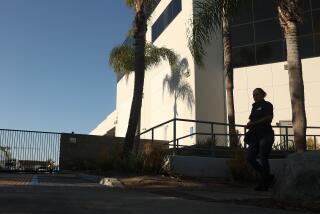When the Atmosphere at Work Is Just Unbearable
In office buildings throughout the country, something’s in the air that’s affecting as many as 21 million workers, according to the Labor Department’s Occupational Safety and Health Administration.
About 1.34 million American office buildings have air quality problems that can lead to employee health risks, the agency estimates.
Over the last decade, physicians’ caseloads for building-related illnesses have increased more than 40%, according to BusinessWeek. Still, many such ailments go undiagnosed. Workers visit physicians complaining of chronic symptoms that worsen on the job, but the doctors can pinpoint no cause.
Some refer to these work-related syndromes as “office-itis” or “Monday morning blahs,” blaming them on psychological problems or stress when in fact they are caused by workplace environment problems.
“Work is under-recognized as a cause of problems,” said Linda Rosenstock, dean of UCLA’s School of Public Health and a former director of the Centers for Disease Control and Prevention’s National Institute for Occupational Safety and Health.
There are many reasons diagnosis of indoor air-related ailments has proved so difficult. Pollutants can trigger different reactions in workers. Some remain unaffected while others with asthma, allergies, respiratory diseases or compromised immune systems experience severe symptoms.
Pollutants’ potency, quantity and exposure duration can vary markedly within an office, as when one workstation is beneath a dirty air vent. And though individual contaminant levels may be below suggested workplace exposure standards, in combination, the pollutants can prove hazardous, said Dr. Kent Peterson, president of Occupational Health Strategies in Charlottesville, Va.
Indoor air levels for many pollutants can be two to five times higher--and sometimes more than 100 times higher--than outdoor levels, according to the Environmental Protection Agency, which over the last 25 years has identified measurable levels of more than 107 known carcinogens in offices.
“There isn’t typically any single substance causing the problems,” said Timothy Morse, assistant professor at the University of Connecticut Health Center in Farmington, Conn. “It’s low-quality air.”
Some workers’ symptoms--headache, fatigue, dizziness, nausea and impaired judgment--can be compounded by factors other than indoor pollutants, such as inadequate lighting, noise, vibration, ergonomic discomfort and job-related stress.
Frequently, these factors are the exclusive cause of employees’ complaints, said Stuart Salot, president of CTL Environmental Services in Harbor City.
“We don’t deny that people’s symptoms are real,” he said. “But about 90% of the time, we don’t find a smoking gun, any single causative agent.”
That knowledge is little consolation to “sick-building syndrome” sufferers, many of whom only know that their symptoms get worse while they are at work and lessen when they are away.
Diana Scott, an attorney at Greenberg Traurig in Santa Monica, has dealt with sick-building syndrome both professionally, in her capacity as an employment lawyer, and personally, as an allergy sufferer whose condition worsened during the 11 years she was a tenant in dusty downtown Los Angeles offices.
“In the winter months, when they turned on their heating systems, you could just smell and feel the dust in the air,” she said.
Scott intermittently suffered from a chronic cough and watery eyes. She kept an air filter in her offices and said she had to work at home on a few occasions. Her symptoms improved five years ago when she relocated to her present office, she said.
During the 1970s energy crisis, sealed buildings were designed to cut costs. Because their windows were permanently shut, they contained mechanical ventilation systems to exchange indoor air with relatively cleaner outdoor air.
But unforeseen stressors, including higher occupancy rates and contaminant-generating office equipment and supplies, have taxed the sealed buildings’ heating, ventilation and air-conditioning systems, or HVAC.
Overcrowded conditions in some offices have increased transmission of illnesses such as flu, colds and measles and also have raised carbon dioxide levels.
Common office fixtures such as printers, computers, copy machines, solvents, toner, paints, furniture, fabrics and marking pens emit volatile organic compounds that, even at low exposures, can affect individuals’ ability to concentrate, according to a Danish study.
Many office buildings are poorly designed. Their air intake vents are over loading docks and in parking garages, permitting vehicle exhaust fumes to circulate throughout workplaces. Others, whose smoking occupants congregate outside entranceways, have revolving doors that suck secondhand smoke back indoors.
Cost-Cutting Can
Exacerbate Problems
Some building engineers try to cut costs by reducing outdoor air exchange rates and shutting off ventilation during non-work hours.
And during tough economic times, many building owners neglect necessary HVAC repairs and maintenance, according to OSHA. This can result in microbial growth in humidifiers, dust and dirt buildup in ductwork, and contamination of air intake vents with bird droppings.
The proliferation of fungal spores, bacteria, viruses, pollen and protozoa from mold growth can very seriously affect office workers. Mold, in certain cases, can produce toxic compounds.
Improperly maintained air-cooling towers--present in most large buildings--can collect standing water at their bases and breed bacteria such as Legionella, which causes Legionnaire’s disease, a virulent form of pneumonia that infects an estimated 10,000 to 15,000 Americans annually, according to the Centers for Disease Control and Prevention.
Four months ago, a Ford Motor Co. plant in Cleveland shut down for nearly a week after five employees contracted the disease, which may have originated from bacteria in the plant’s HVAC system. Two of the workers died.
But the most common cause of poor indoor air quality remains inadequate ventilation, according to the National Institute for Occupational Safety and Health. In industrial settings, substandard air quality can be mitigated through engineering controls and personal protective equipment. However, most offices lack this support.
Though the EPA considers indoor air quality one of the top five environmental health risks of our time, no federal regulations yet govern it.
And OSHA has standards in place only for certain individual contaminants such as benzene and formaldehyde. But it requires employers to provide workers with safe workplaces, said attorney Helen Arntson of Preston Gates in Seattle.
So it’s up to employers to voluntarily create healthy workplaces--but they have little incentive to do so. As energy costs increase and corporate belt-tightening continues during the current economic slump, firms may be reluctant to incur expenses to improve the quality of their workplaces’ indoor air.
Some employers fear that by educating workers about indoor air hazards, they may spark a rash of complaints, both founded and unfounded, said William Pagano, regional medical director of Concentra Medical Centers in Secaucus, N.J. Indeed, investigations of “sentinel cases” (single complaints of indoor air-related illness) often turn up additional cases that had gone unreported by affected workers, he said.
Researchers at the Lawrence Berkeley National Laboratory estimate that U.S. companies could save as much as $58 billion annually by preventing sick-building illnesses and could benefit from $200 billion in productivity increases each year.
Workers face mounting challenges too. Those suspecting that they’ve become ill from indoor air contaminants incur substantial out-of-pocket expenses trying to isolate the cause.
And as the job market tightens, some may not be able to leave what might be an unhealthy workplace.
There’s hope for them, though, according to the Western Journal of Medicine. Scientists are developing new methods to measure contaminants and are devising more sensitive epidemiological techniques for building inspections.
These advances are helping investigators better identify organisms responsible for ill health in the workplace.
(BEGIN TEXT OF INFOBOX / INFOGRAPHIC)
Assessing Indoor Air Quality
Concerned about unsafe indoor environmental conditions in your workplace? Here are some recommendations to keep your workplace safe:
* Have a building expert conduct a walk-through inspection of your premises.
* Consider hiring a consultant to do air sampling if workers are reporting chronic symptoms that resolve only when they leave the building.
* Make sure your heating, ventilation and air-conditioning systems are maintained properly. Cooling towers should be cleaned at least every six months and regularly treated with chemicals to control bacteria.
* Don’t install carpeting in moist areas or near drinking fountains. Fix plumbing leaks and keep humidity below 60%.
* Whenever possible, use nonchemical pest management.
* Look for the following problems that may indicate air quality concerns: odors, dirty or unsanitary conditions, visible fungal growth, mold or mildew, moisture in inappropriate locations, leaks, uneven temperatures, overcrowding, staining or discoloration of building materials, smoke damage, presence of toxic substances, poorly maintained filters, potential for gas entry, unusual noises from equipment, blocked or redirected vents and diffusers, and unsanitary debris near outdoor air intakes.
Sources: Environmental Protection Agency, Centers for Disease Control and Prevention
More to Read
Sign up for Essential California
The most important California stories and recommendations in your inbox every morning.
You may occasionally receive promotional content from the Los Angeles Times.










